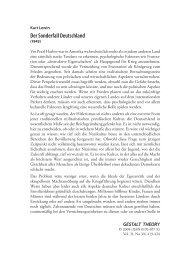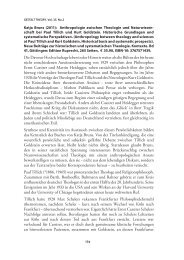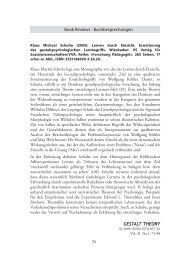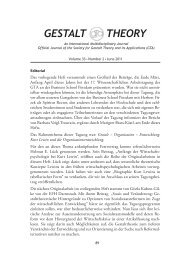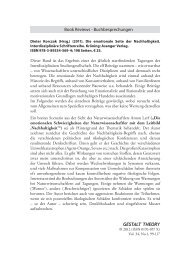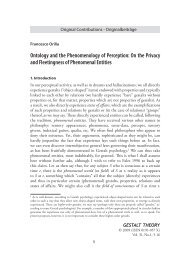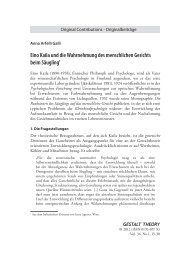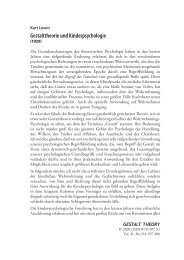What is the Meaning of Shape? - Gestalt Theory
What is the Meaning of Shape? - Gestalt Theory
What is the Meaning of Shape? - Gestalt Theory
Create successful ePaper yourself
Turn your PDF publications into a flip-book with our unique Google optimized e-Paper software.
409<br />
Pinna, <strong>What</strong> <strong>is</strong> <strong>the</strong> <strong>Meaning</strong> <strong>of</strong> <strong>Shape</strong>?<br />
More important than <strong>the</strong>se conditions are <strong>the</strong> following ones <strong>of</strong> Figs. 17d-e, where<br />
<strong>the</strong> pointing clearly influences <strong>the</strong> shape <strong>of</strong> <strong>the</strong> triangles, thus demonstrating<br />
that <strong>the</strong> pointing <strong>is</strong> a shape property. Geometrically <strong>the</strong> triangles are <strong>is</strong>osceles,<br />
never<strong>the</strong>less due to <strong>the</strong> pointing induced by <strong>the</strong> two kinds <strong>of</strong> accentuation<br />
(rectangles and circles), <strong>the</strong>y are perceived like scalene triangles. More in details,<br />
because <strong>the</strong> perceived pointing <strong>is</strong> not in <strong>the</strong> direction <strong>of</strong> <strong>the</strong> angle created by<br />
<strong>the</strong> two longer sides, th<strong>is</strong> induces an asymmetrical effect that propagates and<br />
determines <strong>the</strong> whole shape <strong>of</strong> each triangle making it appear as scalene.<br />
These results suggest that <strong>the</strong> pointing and all <strong>the</strong> o<strong>the</strong>r meta-shape attributes<br />
here studied are <strong>the</strong> main attributes responsible for <strong>the</strong> shape formation. They<br />
can explain what a shape <strong>is</strong>.<br />
Variations in <strong>the</strong> pointing <strong>of</strong> sides or vertices, due to <strong>the</strong> accentuation, clearly<br />
influence <strong>the</strong> shape <strong>of</strong> figures as shown in Fig. 18. Under <strong>the</strong>se conditions, <strong>the</strong><br />
rows <strong>of</strong> irregular quadrilaterals are perceived as different shapes, difficult to<br />
recognize as <strong>the</strong> same figures. By determining <strong>the</strong> shape, <strong>the</strong> accent determines<br />
also <strong>the</strong> orientation <strong>of</strong> each specific shape and <strong>the</strong>refore <strong>the</strong> shape-related<br />
information about its rigidity and surface bending in <strong>the</strong> 3D space. The bending<br />
region <strong>is</strong> easily and immediately perceivable and its location changes in relation<br />
to <strong>the</strong> accent position within <strong>the</strong> figure. These results suggest <strong>the</strong> kind <strong>of</strong> v<strong>is</strong>ual<br />
organization and <strong>the</strong> new conditions illustrated in <strong>the</strong> following section.





